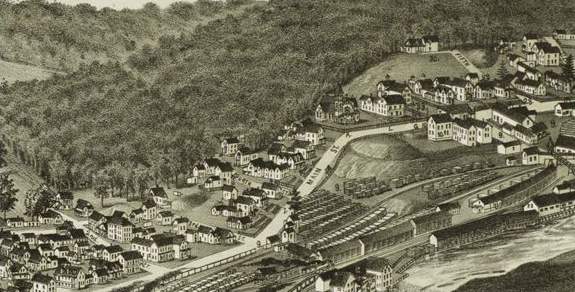
Abenaki Lane (1st Street), Birch Street (2nd Street); Peavey Lane(3rd Street); Hemlock Lane (4th Street); Maple St. ; Heritage Lane (Brown St.) south side of Iceland Street (5th Street) and adjacent parts of Main Street. (Note that Norwegian Village (north side of Iceland Street north to 11th Street) is technically an 1896 addn. to Berlin Mills Village but is discussed as a separate neighborhood.)
In the town’s early years, Berlin consisted of two villages set on the Androscoggin: Berlin Mills Village — the more northerly area of town adjacent to the various parts of Berlin (Winslow) Mills — and Berlin Falls, the more southerly area closer to the Dead River. In between these two villages there was little development. “The narrows” (an area where the road narrowed due to a ledge outcropping) was the dividing line between the two areas;everything north of it was considered part of the Berlin Mills Village.
Although Berlin Mills sold lots in the area prior to this, a plat for the area was drawn up in October 1881 (below). The area included the west side of Main Street on either side of Berlin Mill. Streets off of Main were numbered 1st Street through 7th Street. (Thus later Berlin Mills was referred to as “the Streets” — in contrast to “the Avenues” neighborhood which had numbered “avenues” versus “streets.”) In December 1893, Berlin Mills Village Addition #1 expanded the original area to include the north/south part of Maple Street. Berlin Mills Village Addition #2 (1896) was Norwegian Village.
Located an equal distance from Berlin Mills and the Forest Fibre Company, by the 1890s Berlin Mills Village was already a densely developed area with a significant number of “tenements” that housed workers in both mills.
Today there are a number of tangible reminders of the early era of Berlin Mill Village. A key Berlin Mills building is the Brown Company House (above), roughly in the center of the old village and facing the site of the early mill. It was built in 1853 by the H. Winslow & Co. (Berlin Mills’ predecessor) to house workers at the sawmill. According to Poof Tardiff it is the oldest stick-built structure in Berlin.

Congregational Church (1882) Francis Fassett and John Calvin Stevens, architects (Berling Reporter 11/26/1896)
The Congregational Church, built in 1882 and located at 921 Main Street was built on land donated by Berlin Mills. W. W. Brown was a major contributor to the cost of its construction. It was designed by Francis Fassett and John Calvin Stevens (see St. Anne’s neighborhood). Although it was the first congregation in Berlin; the building was completed somewhat later than the first St. Anne’s church.
In later years “the Streets” grew more densely developed, with increasing numbers of multifamily houses. It was one of a number of areas in the city that were strong enclaves of French Canadians and, later, other new groups of immigrants to Berlin.





 Follow
Follow